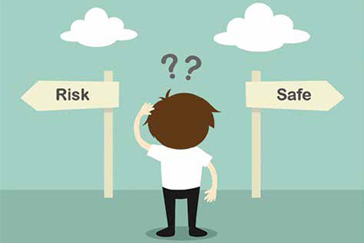Which is better – to be a reckless doer or a fearful non-doer? The best option is to avoid both extremes. Experts tell us that we must stop thinking of risk as just a do-or-die situation. Instead, we must start thinking of risk as a journey of exploration

“No pains, no gains,” says an old fashioned proverb. “Nothing ventured, nothing gained,” is another wise saying. It is only because the early Homo sapiens took calculated risks, that you and I live in the advanced civilization of the twenty-first century! If your life is absolutely free of failures, chances are that you have not taken risks, and thus lost the chance of learning many valuable lessons in life. Therefore, the management pundits tell us: “The person who risks nothing, does nothing, has nothing, is nothing, and becomes nothing. He may avoid suffering and sorrow, but he simply cannot learn and feel and change and grow and love and live.”
Quite apart from success or failure, you learn to face the truth about yourself, when you take risks, with faith in God, and confidence in yourself, you learn to do what you think you cannot do; you learn to do what is hard for you to do; you learn to take the initiative; you learn to take the responsibility for your own actions. As the French humanist Andre Gide tells us, “Man cannot discover new oceans unless he has the courage to lose sight of the shore.”
Risk taking must not be confused with thrill-seeking. By this, I mean reckless behaviour, which leads to many sad accidents and avoidable mishaps. Psychologists call this compulsive novelty- seeking behaviour. It is mostly adolescents who indulge in such behaviour to attract attention and enhance their low self-esteem. Ironically enough, it is in the ‘developed’ countries of the world that such thrill-seeking games abound. Statistics tell us that a disproportionate share of thrill-or sensation-seeking personality types are to be found in the United States, where ‘extreme games’ such as hang gliding, paragliding and dirt cycling are popular.
The kind of risk-taking I am talking about is very different: I refer to situations where we are afraid to venture because we fear that we may not do well. If we limit ourselves to situations where we are sure of doing well, we will never be able to know what we are capable of achieving. We will simply end up by limiting our own opportunities drastically. Maureen Neihart, a clinical psychologist, tells us that we must appreciate the value of taking risks, and also teach our children about well planned, systematic risk taking which can help them become high achievers. According to her, there are six steps to systematic risk-taking:
When we are children, we hardly stop to think of risks; we just go ahead and do what we want. But as we grow older, we restrict ourselves
When we are children, we hardly stop to think of risks; we just go ahead and do what we want. But as we grow older, we restrict ourselves. We draw a circle around ourselves and are reluctant to step out of the self-imposed boundaries. We begin to think of the consequences; we fear the repercussions; we even worry about what people might say.
Which is better - to be a reckless doer or a fearful non-doer? The best option is to avoid both extremes. Experts tell us that we must stop thinking of risk as just a do-or-die situation. Instead, we must start thinking of risk as a journey of exploration. It is not about one-shot success or failure; it is about exploring different aspects of our life and personality.
By Dada JP Vaswani